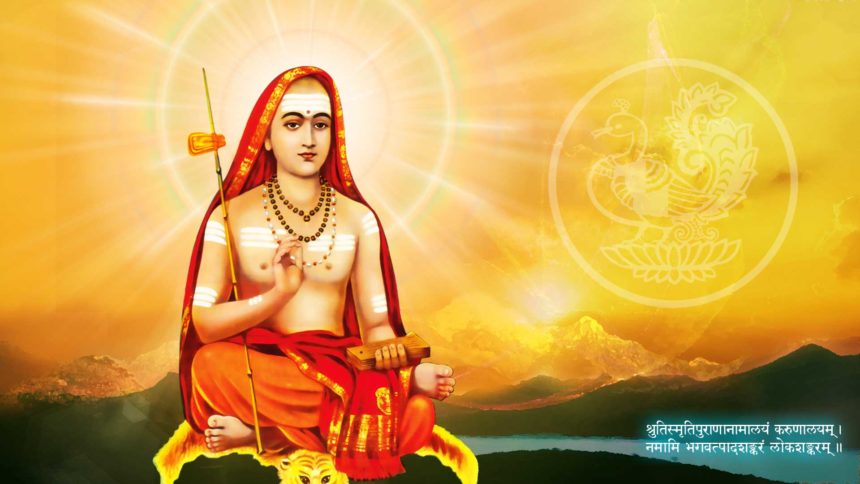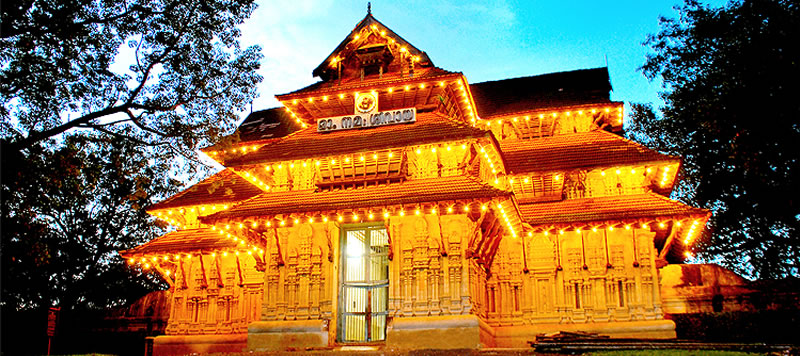Mahadeva is petitioned, and Sivaguru and Aryambha become the vehicles of divine descent.
Śaṅkara Charitam – A Re-telling – Chapter – 02

Introduction
In chapter 1, the prevailing state of adharma was discussed and the rationale and need for an avatāra-puruṣa were clarified. In chapter 2, the prelude to Śaṅkara-avatāra and Śaṅkara’s parents are discussed. Readers must note that this re-telling is not a translation but rather a re-creation of the times and therefore some element of dramatization has been introduced to enhance readability. That, however, does not mean that any liberties have been taken with the original texts from where this re-telling has been sourced – the Mādhaviya-Śaṅkara-Digvijayam of Jagadaguru Śri Vidyaranya Mahaswami, 12th ācārya of Dakshinamnaya Sringeri Sharada Peetam and Śaṅkara Charitam which is a collection of talks given by the Paramācārya of Kānchi, Jagadaguru Śri Chandrashekarendra Saraswati, the 68th Jagadguru of the Kānchi Kāmakoti Peetha and embedded in volume-5 of his seven-volume magnum opus, Deivathin Kural or The voice of God.
The dual petition
As we observe the avatāras and their progression over time, we see how each of the avatāras reflect closely the dynamics of the time and the context in which they are required to descend. Paraśurāma had to wield his axe mercilessly to mete out justice and preserve Dharma. Rāma on the other hand could afford to set the example of being the Maryāda Puruṣottama. Kṛṣṇā we see was more comfortable exhibiting the human side of his personality including his foibles but then was equally at ease in displaying his supreme personality when required. Śaṅkara-avatāra also was a reflection and response to the times. While we will come to this later, it is important to recognize this to appreciate the true purpose of each avatāra.
Furthermore, when we reflect upon the avatāras, one realizes that many of these avatāras are a result of, and in response to two petitions:
- When the Devas and Dikpālas vested with the responsibility of Lokakṣema[1] find themselves losing control and no longer able to discharge their duties to the fullest, they approach the Supreme Being for help. This typically happens when they are in the presence of and/or the world has been taken over by a being or a force that is way more powerful and they require the support and/or the intercession of the Supreme being itself or an aṃśa of the Supreme Being, an avatāra.
- A coming together of circumstances where a couple living in Bhūlōka attain a state of perfection after long years of Sādhana over several lifetimes and become the perfect vehicles to carry the seed of the divine and bring it into the world. When such a couple petitions the Supreme Being, then the Supreme Being decides to enter the world through them for the greater good of the world, i.e., Lokakṣema.
As adharma had seeped into every nook and corner of the world, the Devas and Dikpālas had come together and reached the icy peaks to meet and petition the one without a second, he who is the epitome of all auspiciousness, Śiva, the Devādi–Deva, Mahādeva. They had one goal – to appraise him of the situation in Bhūlōka and seek his help and intervention in putting things back in order. They spoke to him thus:
“Mahādeva, the world is filled with the fraudulent and heterodox – they neither practice nor have they any respect for the eternal Vedas that emerged out of your own nostrils…[2] they indulge in carping criticism of the rules of Dharma, of Varna and Āśrama – they say these are merely superstitious nonsense that prevents them from living a life of their choosing.”
“Furthermore, there is none who performs the Sandhya[3] and the mere utterance of the word yajna makes them cup their ears with their hands…” “If no one performs the yajñas, how will we, the Devas get our offerings that we depend upon to keep us going?” Mahādeva, and that is not all, they heap humiliation and insult on the Vedas, which is a direct insult to you and there is no limit to the perversities that they indulge in. All our efforts at putting things back in order have come to naught – we seek your intervention now or else everything shall be lost…”
As Mahādeva gently opened his eyes, the Devas and the Dikpālas waited with bated breath, for in this response rested the future of Dharma. The earth itself seemed to have stopped in her tracks.
Sivaguru and Āryambha are chosen as the vehicles of the divine descent
Sivaguru had just completed his morning Sandhya and looked up to see Āryambha waiting to join him for the aupāsana yajña anuṣṭhāna. This was something that they had been doing for several years, every day since the time they had entered Gṛhasthāśrama-Dharma several years ago. As Āryambha carefully divided the fistful of rice grains mixed with ghee into two parts, one to be offered to Sūrya and the other to Agni, he looked closely at her hands and noticed the veins as well as the micro-wrinkles spreading across them – signs that she was no longer the young girl who had taken him as her guru and husband. Sivaguru had also noticed the streaks of grey in his own beard – he was already past what one would call middle age and the one regret he had in a life of serenity and happiness was the lack of a progeny who would continue his lineage.
His mind traveled back to his Brahmacārya days, 12 years of study and discipline – the image of his Guru floated into his mind’s eye and his conversation with him came back to him with the force of a hammer. Sivaguru had wanted to take up Sanyāsa and dedicate his life to the pursuit of the truth along with the rigors of lifelong Brahmacāryam. He had argued and pleaded long and hard with his Guru and later with his own father as well, who had sided with his Guru on this matter. The Guru who knew the purpose of Sivaguru’s sojourn on earth in this lifetime, insisted that he wanted him to enter Gṛhasthāśrama-Dharma and through that work for Veda-Rakṣaṇa[4]. If everyone took up Sanyāsa and only spoke of Vedānta, who would practice and preach the Vedas? Gṛhasthāśrama-Dharma was ideally suited for this purpose and the Guru felt that Sivaguru should focus on this. Sanyāsa was always an option later in life.
Returning to the present moment, he reflected upon how, for so many years he had done what his Guru had asked him to do, studying, practicing, and teaching the Vedas, following the rules of Gṛhasthāśrama-Dharma. However, there was a deep sadness within him – the lack of a child who would follow in his footsteps after him. As he closed his eyes in deep thought, the perceptive and devoted Āryambha noticed the crinkles and lines on his forehead morph into deep furrows of grief and worry. She looked at him with an enquiry in her eyes and he poured out his grief. She too had for long wanted to feel the weight of a child in her womb, the pleasure of motherhood and the joy of raising a child, to hear the laughter echo from the walls of their house, and had wondered why she and Sivaguru had been deprived of this simple joy. They had everything going for them – a house that was filled with the resonance of the Vedas, land that offered them the best of fruits and vegetables, and the Pūrṇa river drenched their fields and quenched their thirst with sweet water that tasted like nectar – despite all this, the lack of a child left an unfillable void in their lives.
Who could they talk to about their grief and who could they approach? It was at this moment that Āryambha was reminded of their kula-devatha, Wadakkunathan, Mahādeva himself who resided here in the form of a lingam covered in ghee (clarified butter). The ghee here is never removed and new offerings of ghee are poured over the old – charged with the power of mantras and the divine presence of the essence of Mahādeva, the ghee is considered a Sarva-Rhoga-Nivārini – medicine to cure all ailments and afflictions across the physical, mental, emotional, and spiritual realms of our existence.

Āryambha told Sivaguru that perhaps it was time for them to ask Wadakkunathan’s help in this regard. They had never asked for anything thus far but surely asking for a child was allowed. Sivaguru smiled at the wisdom in the words of Āryambha and nodded his head in agreement.
Sivaguru and Āryambha decided to take up the mandala-vratha-pūjā – 41 days dedicated to the worship and adoration of Śiva in the form of Wadakkunathan with fasting, strict rules, and upavāsa. On the completion of the 41 days, they would go to the Wadakkunathan temple located approximately 50 kilometers from Kaladi to Thrissur, on foot and place their petition for a son at the feet of Mahādeva. Then, it was up to him. Sivaguru and Āryambha wasted not even a moment and immediately started the mandala-vratha-pūjā with utmost dedication and Śraddhā.
Forty-one days later, Sivaguru and Āryambha started the trek to Thrissur and the Wadakkunathan temple. During their time the lingam was perhaps still under the huge banyan tree known as the Sreemoola Sthanam, the place where Paraśurāma himself had worshipped and consecrated the lingam several thousand years ago. As they stood in front of the huge lingam and prayed, offering water and flowers to Mahādeva, a gentle breeze picked up one of the flowers and blew it right onto the lingam itself. At that precise moment, Mahādeva who was listening to the petition of the Devas and Dikpālas, picked up the flower and a gentle smile caressed his austere countenance – Mahādeva had made his decision, he had chosen the vehicles for his descent into Bhūlōka.
A short note on the Wadakkunathan temple:
The Wadakkunathan temple is identified as Vrushachala in the Mādhaviya-Śaṅkara-Digvijayam – that’s perhaps because of how the temple is located on a slightly elevated landmass in the middle of the city of Thrissur. It is a sprawling complex spread across 9 acres (a little over 36,000 Sq. meters) enclosed within a massive stone wall that runs all along the periphery. Within this fortified space are four gopurams facing the four quarters. The South and North gopurams are usually closed and devotees enter through the East or West gopuram entry points. The inner temple has a spacious “Chuttambalam” – a circular pathway or corridor that is separated from the outer peripheral and larger corridor. A central passage in the middle of the “Chuttambalam” leads into the main temple. The main deity is Śiva, worshipped in the form of a 16-foot lingam. A devotee today would not be able to see the lingam because it is completely covered over by mounds of ghee that have cascaded down the lingam over several hundred years during the daily abhiṣekam. The front of the lingam is embellished with a series of 16 concentric crescents and topped over by three serpent hoods.
The temple also has sannidhis for Gōśālā Kṛṣṇā, Nandikeśvara, Paraśurāma, Aiyappa, and Ādi Śaṅkara. The Brahmāṇḍa Purāṇa says that this lingam was consecrated by the great Paraśurāma himself.[5]
To be continued…
[1] Lokakṣema = welfare of the world. The Devas and Dikpālas work towards keeping things in order across the four quarters of the world.
[2] The Vedas are considered to be the life-breath of Bhagavān – Nishvasitam is the term used – that which was breathed out of the nostrils of the supreme being himself
[3] Sandhya = Sandhyāvandanam performed Trikāla or three times in a day at the meeting points or Sandhya-kālas of dawn, dusk, and noon
[4] Veda- Rakṣaṇa = protection of the Vedas through the practice and teaching of the Vedas
[5] Read more here: Sree Wadakkunathan Temple

Leave a Reply